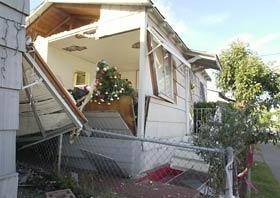| |
Claim:
Insect-infested house is destroyed when too many "bug bombs" set by
owner are ignited.
Status:
True.
Origins:
In December 2003, an overly determined householder in San Diego,
California, took on the bugs and lost her home in the process.
"Bug bombs" are aerosol insecticide foggers used to exterminate a
residence's insect population, commonly purchased in home improvement
stores by those intent upon ridding their domiciles of cockroaches, fleas,
and the like. After the homeowner has cleared his house of kids, pets, and
other residents, he sets off the fogger by pressing down on a tab atop the
can; the
"bug bomb"
then begins to produce a fine mist of insecticide, continuing this
"fogging" at a slow and steady rate until the canister is empty. After a
few hours, the residents of the house (adults, kids, pets) can return to
their (presumably) insect-free home, air it out, and take up residence
again. One canister is generally sufficient for a 600 square
foot space. Sounds simple, right? It is — provided you don't
overdo it.
 |
Nineteen of these foggers were set off in Aurelia Oliveras'
470-square-foot home in San Diego. Everything might have turned
out well in spite of the excess had the
pilot light in a water heater
not ignited the fumes concentrated in this small space.
The resulting explosion blew apart the structure and hurled Christmas
decorations into the street, strewed shards of glass (from broken
windows) and nails (from torn walls) like shrapnel, blew the back door
off its hinges, ripped gaping holes in the ceiling, spread insulation
over the yard like confetti, and crashed the south wall of the house
into the side of the home next door — all in all
resulting in damages estimated at more than $150,000. |
Fortunately no injuries resulted, as Oliveras, her husband, and her
2-year-old daughter were in the back yard at the time of the kaboom.
This type of accident had occurred
before in San Diego. In April 2001, another fog of insecticide from
eighteen bug bombs was similarly set off by a pilot light, this time
blowing up an apartment in the City Heights neighborhood. No one was
injured, but several cockroaches managed to survive the blast. Elsewhere
in southern California, another pilot light ignited the fumes from three
bug bombs set off in a Los Angeles apartment in September 2003,
blowing out windows and splintering kitchen cabinets. Also in Los Angeles,
in April 2001 a woman suffered second-degree burns to her
legs from the heat of a blast resulting from the ignition of thirty bug
bombs she set off in her home. That explosion shattered windows and lifted
the dwelling's roof three inches.
Given the force of these blasts, it's surprising that more people aren't
injured.
According to the California Department of Pesticide Regulation (CDPR),
a number of such explosions occur every year, typically when homeowners
use too many foggers and don't shut off ignition sources
(particularly pilots lights in ovens, stoves, and water heaters). In this
battle between man and insect, more is certainly not better. Those still
contemplating the use of an arsenal of bug bombs in their wars with
six-legged foes should consider this: If the possibility of a horrendous
explosion doesn't talk you out of it, the fact that roaches often survive
the megabombing
should. Little can compare to seeing your home in ruins, its windows and
walls blasted out, its roof lifted, and the whole of the house shifted off
its foundation . . . but with roaches still scurrying about
the ruins. Yet a number of foolhardy homeowners have created just such a
scenario.
Barbara "bombs away" Mikkelson
Texas
A tenant in an apartment complex in
Hitchcock, Texas, had a roach problem.
So she and a maintenance man set
off foggers -- but they used 18! That's what caused the explosion.
The explosion ripped through one
apartment -- blowing the door out, buckling brick walls and causing
extensive damage to the inside of the apartment. Two people were injured.
Tenant Cora Lee Jones heard the explosion across the walkway.
She recalled, "I came outside and I saw the tenant from the apartment that
exploded running out, and then all of a sudden she just fell out in the
parking lot. She just collapsed. She was just screaming." Witnesses say it
was 8am Friday and many people were still in bed. Nikki Henderson was
right next door to the apartment where the explosion took place. She was
in bed with her three-year-old son.
Although the bed where Henderson and her son were sleeping is covered with
scraps of sheetrock, they were unharmed.
|
|


